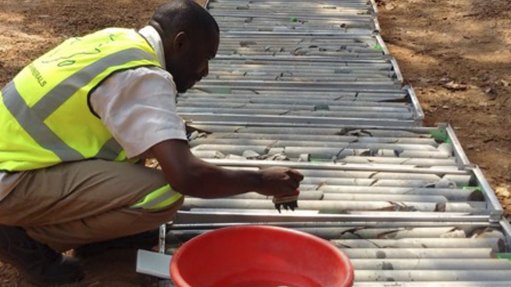
KAMOA-KAKULA The combined Kamoa-Kakula indicated mineral resources as of a May estiimate is about one-billion tonnes, grading 3.02% copper, containing 66-billion pounds of copper
The first blast at the Kamoa-Kakula mine development, marking the start of work on the twin declines at the ultrahigh-grade Kakula discovery, in the Democratic Republic of Congo (DRC), has been completed ten days ahead of schedule.
The successful blast at the Tier 1 copper project, near the mining centre of Kolwezi, was announced by Canadian mineral and exploration company Ivanhoe Mines executive chairperson Robert Friedland and CEO Lars-Eric Johannson last month.
The Kakula boxcut was completed on October 26 and the first blast for the twin declines at Kakula took place on November 16. The Kakula decline development work is being undertaken by the DRC subsidiary of China mining construction company JCHX Mining Management, JMMC. Depending on ground conditions, the 3 600 m decline development contract is scheduled for completion in about one year.
Ivanhoe Mines and Chinese mining group Zijin Mining each hold an indirect 39.6% interest in the Kamoa-Kakula project, while private investment vehicle Crystal River Global holds an indirect 0.8% interest and the DRC government holds a direct 20% interest.
In response to the exploration success at the Kakula discovery, Ivanhoe Mines and Zijin Mining are fast-tracking the mine development programme at Kakula. Of the 14 rigs continuing to drill at Kamoa-Kakula, ten are focused on expanding and upgrading the resources in the Kakula high-grade zone along trend to the west and south-east.
A fresh resource estimate for Kakula is being prepared and is expected to result in a major upgrade and expansion of the Kakula mineral resources.
The May mineral resource estimate prepared by leading engineering and project management multinational in energy and industrial markets Amec Foster Wheeler states that the combined Kamoa-Kakula indicated mineral resources is about one-billion tonnes, grading 3.02% copper, containing 66-billion pounds of copper and another 191-million tonnes of inferred resources at 2.37% copper, at a 1.4% copper cutoff grade.
Results from drill holes completed in October will form the basis of the planned updated mineral resource estimate encompassing the entire strike length of the Kakula discovery, which now extends to at least 12 km. This would represent an increase of about 60% in the strike length that will be used to calculate the new resource estimate, compared with the 7.7 km strike length covered by Kakula’s May resource estimate. The updated resource estimate is expected to be issued in January 2018.
“We’re looking forward to providing our shareholders and all Kamoa-Kakula stakeholders with another substantial resource expansion soon after the coming holiday season,” said Friedland.
Meanwhile, the new Kamoa-Kakula project preliminary eco- nomic assessment (PEA) is pro- gressing well and Ivanhoe expects it to be completed this quarter. The PEA is based on an initial mine capacity of six-million tonnes a year at Kakula using the May mineral resource estimate, with an additional six-million-tonne-a-year mine at Kansoko planned to serve a centralised concentrator at Kakula. This presents projected mine production of about 12-million tonnes a year from the presently delineated Kamoa and Kakula deposits.
The company announced that, in addition to the PEA study, preliminary work is under way on a six-million-tonne-a-year prefeasibility study at Kakula, which will be based on the upcoming January 2018 resource model.
The study will be considered as the base case for the first phase of development at Kamoa-Kakula. “In light of the successful step-out drilling at Kakula West, the Kamoa-Kakula development plans will be reassessed and amended as the project moves forward. Potential phased mine developments of up to 18-million tonnes a year are also being assessed for the Kamoa-Kakula copper complex,” explains Ivanhoe.
The Kamoa-Kakula project is a large, stratiform copper deposit with adjacent prospective exploration areas in the Central African Copperbelt and it was discovered by Ivanhoe (then named Ivanhoe Nickel & Platinum) in 2008, followed by the discovery of the Kakula deposit in early 2016.
“The Kakula copper deposit is a gently-dipping blanket of thick, chalcocite-rich copper mineralisation. Initial mine development is planned to begin in the flat, near-surface zone, which, at a 3% cutoff, is between 7.1 m and 11.7 m thick, with copper grades between 8.11% and 10.35% along the deposit’s axis,” states Ivanhoe.